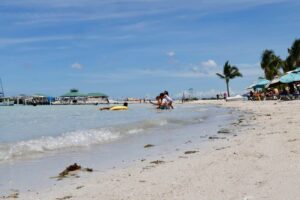Researchers have reported for the first time the presence of the jellyfish invasive Phyllorhiza punctate in La Gina, Miches. This finding, recorded on February 20, 2024, represents a significant expansion of the species’ range in the region of Caribbean and raises serious concerns about its impact on ecosystems local marine species. A single specimen was reported by the Dominican Foundation for Marine Studies (Fundemar) during the Manatee Photo-Identification project carried out nationwide.
During a technical drone Flight it was possible to observe the jellyfish the morning of February 21 of this year. According to testimonies of fishermen Locals who observed the animal through the drone screen, it is not the first time they have seen this species, although they could not specify the number or dates of the sightings.
According to a scientific study of the University of Florida entitled “First appearance of the jellyfish invasive Phyllorhiza punctate in the Dominican Republic: seasonal trend and invasion in the Atlantic Ocean”, a multidisciplinary team participated in this first official report made up of researchers from the Institute of Marine Sciences of Cuba, Fundemar and the University from Cadiz, Spain. The authors include Ramon Damian Morejon-Arrojo, Rita Sellares-Blasco, Sergio D. Guendulain-Garcia, Leandro Rodriguez-Viera and Marvin del Cid.
Characteristics of the invasive species: Phyllorhiza punctate
Phyllorhiza punctatecommonly known as the “jellyfish of white dots or jellyfish “australian” is native to the western Pacific Ocean, from Australia to Japan, but has been introduced to various regions of the world. It feeds mainly on zooplankton and can reach up to 50 centimetres in diameter, although a 72 centimetre specimen has been recorded in North Carolina.
Its life cycle has two stages: jellyfish (adult) and polyp (juvenile). In the adult stage, females fertilize their eggs with sperm released into the water by males, and the larvae settle on the seabed where they become polyps, which reproduce asexually.
Impact on the ecosystems and the economy
This jellyfish It thrives in warm waters and can cause the destruction of fisheries and ecosystems due to their ability to consume large amounts of zooplankton, which affects other speciesAlthough its venom is of low intensity and does not pose a threat to humans, its ecological impact is significant. Phyllorhiza punctate It has been introduced into several regions, such as the Gulf of Mexico, the Mediterranean, the Caribbean and other areas outside their natural habitat.
The appearance of Phyllorhiza punctate in the Dominican Republic can have serious consequences for the species natives and the ecosystems sailors. This jellyfish competes with species native species for resources such as fish and crustacean larvae, which could affect the population dynamics of these species. Furthermore, their ability to become entangled in fishing nets can cause significant problems in the fishing industry, affecting both the productivity and sustainability of activities.
Seasonal trend of invasion
The analysis of 57 previous records of Phyllorhiza punctate in it Caribbean and the Gulf of Mexico between 1965 and 2023 reveals a clear seasonal pattern: the most of the sightings occur between May and Octoberduring the rainy season. This seasonal behavior suggests that the weather conditions and environmental factors play a crucial role in the emergence of this species, which could be linked to rising ocean temperatures due to climate change.
Necessary actions: monitoring and regional collaboration
Experts call for urgent implementation of a monitoring continuous of Phyllorhiza punctate in the region of CaribbeanCooperation between countries and the participation of citizen science initiatives are essential to evaluate the expansion and impact of this invasive species. Additionally, it is crucial to regulate the transport of ballast water and the release of species of aquariums, two of the main vectors of its introduction.
The joint work of local and regional institutions will be essential to develop effective management and mitigation strategies that minimize the ecological and economic impacts of this species on the Dominican Republic and throughout the region of Caribbean.
Fundemar executive director Rita Sellares told Free Newspaper: “This observation in the area and in other areas of the country has probably occurred before, however we do not have any record. Therefore, communicating and reporting these observations is important, because we are facing a invasive species and, like all of this kind, has negative effects on the ecosystems “locals”.
“The report is important not only for the Dominican Republic – he added – but at a regional level (Caribbean) and worldwide. It is important to know the distribution of the species marine. And especially the Invasiveremembering what we experienced with the lionfish.”
For his part, the Cuban marine biologist and jellyfish expert, Ramón Damián Morejón-Arrojo, explained that this species is a natural predator which feeds mainly on small crustaceans, eggs and larvae of commercially interesting fish that it finds in the water column, causing an effect on the food chain and on fish recruitment.
“The severity depends on how frequently it is observed and how abundant the species is in the areas where it invades. Through the report we raise the alert and invite people to motivate its reporting,” said the expert.



